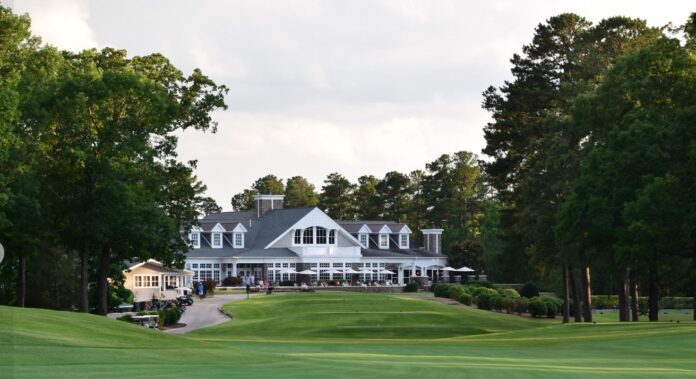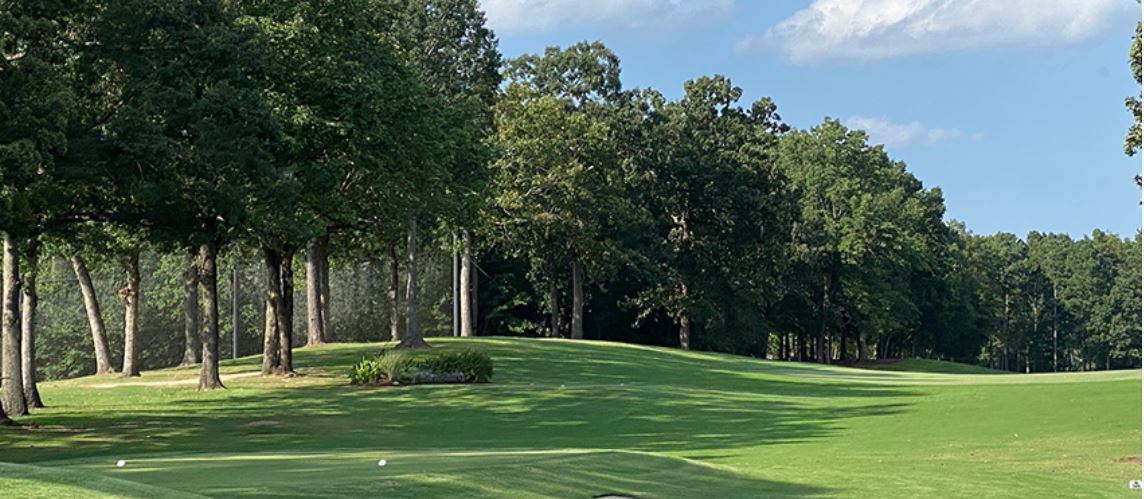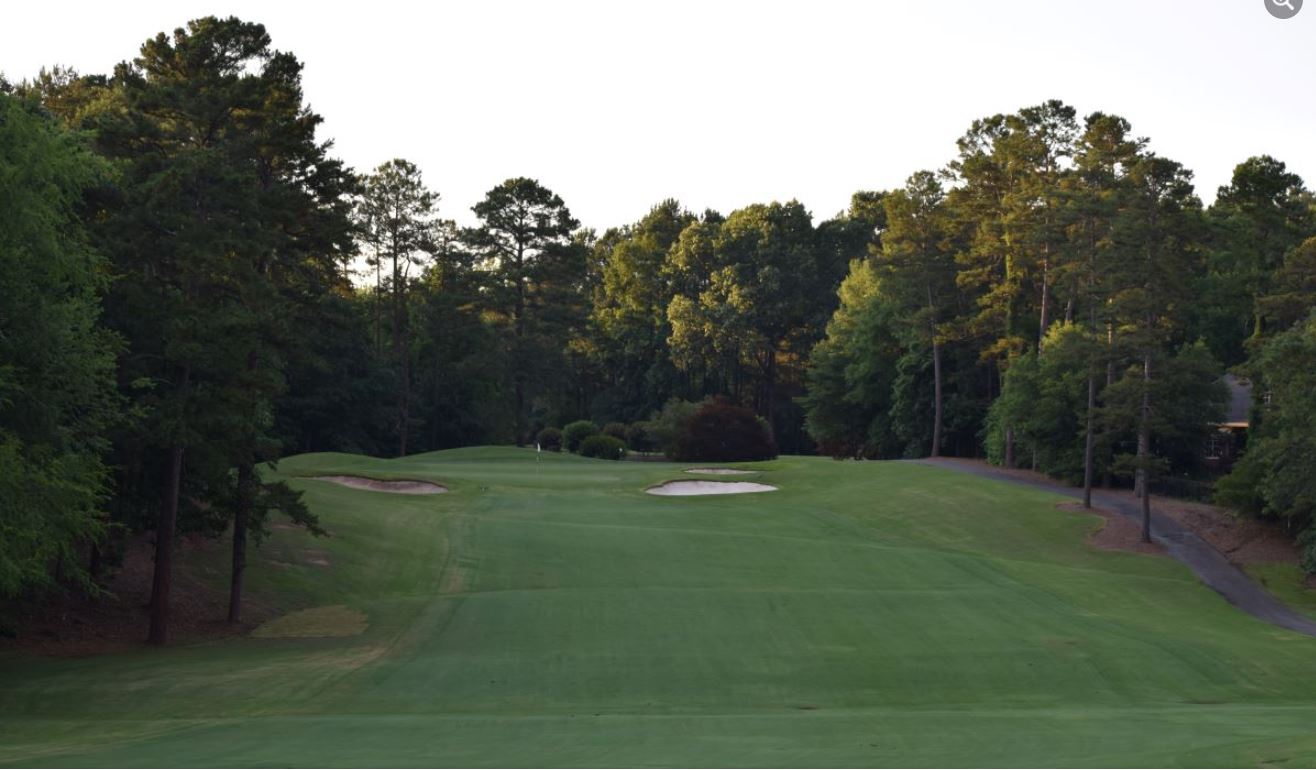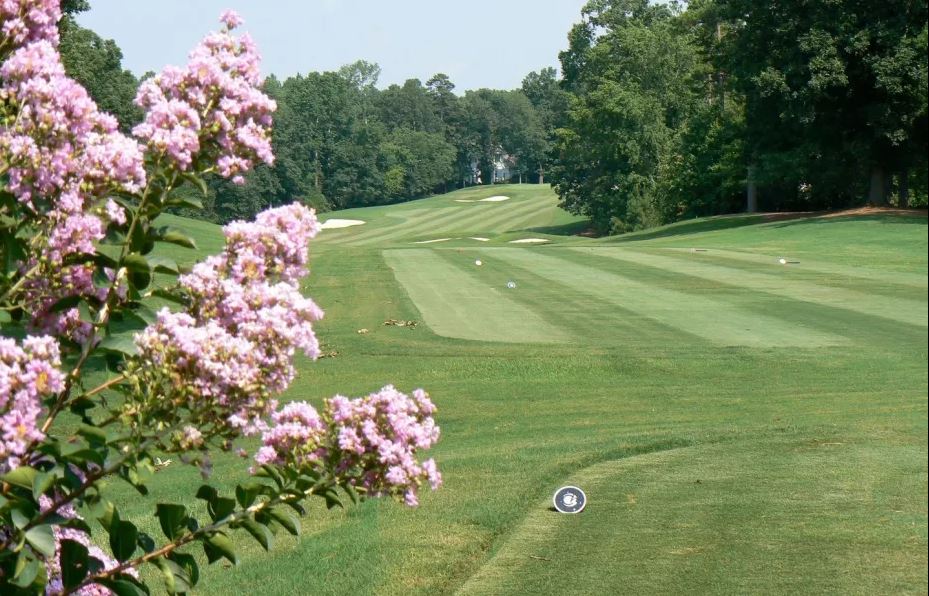
by FRANK R. GIORDANO, JR.
CHAPEL HILL, North Carolina – It it began as a modest, nine hole course in the center of the sleepy university town of Chapel Hill in 1922, but the evolution of both the university and town led to the Chapel Hill Country Club’s relocation, a little more than a driver and wedge away, to its current location off campus in the heart of the elegant Oaks neighborhood. Having celebrated its centennial anniversary just a year ago, the current club has emerged as one of the premier private country clubs in the Triangle area of central North Carolina.
The club wisely selected Gene Hamm to design their new course, which opened for play in 1972. A native North Carolinian from Raleigh, Hamm learned his golf competing successfully as a PGA professional, often on the state’s many Donald Ross golf courses. The influence of Ross’ work on his imagination emerged when Hamm became involved in golf course design himself, creating over 60 fine layouts throughout the Mid-Atlantic region, particularly in the Pinehurst and Myrtle Beach areas. Working for Ellis Maples, a designer of many superb courses throughout the state and the son of Ross’ right-hand man Frank Maples at Pinehurst Country Club, Hamm absorbed much of those masters’s philosophy and vision of how great courses should look and play.
When he went to work for Robert Trent Jones on the Duke University golf course, and continued working for Jones until starting his own design firm in Raleigh, Hamm had the advantages of learning from and working for both the master designers of the early and mid Twentieth Century. A significant product of his apprenticeship under those iconic architects is the 18-hole Chapel Hill Country Club, which measures 6752 yards from the tips and today has a slope rating of 130 and a 72.2 USGA rating. The club’s diverse membership benefits from five sets of tees, to ensure an enjoyable golf experience for every member, young and old, man or woman, regardless of their different skill levels.

On arriving at the club, one’s first impression is created by the broad, tiered, Champion Bermuda putting green. One of the chief varietals on greens at quality courses throughout the South, this hardy, slick, all-season grass was introduced in 2017, nearly two decades after John LaFoy redesigned Hamm’s original layout in 1999. According to J.P. Morrison, the club’s Director of Golf, the Champion greens immediately elevated his course to the top tier among the region’s layouts. “The grass loves to grow, even in 100 degree temperatures in summer. And it’s a fine surface for courses like ours, which are open all year long.” A solid practice session on the putting green is a must, for all players, as the key to scoring well at Chapel Hill Country Club, is going to be putting. And as the grass is so fine and so fast — running about 11.5-12 on the Stimpmeter — developing a feel for the speed and managing the delicacy of touch on these exquisite greens is crucial.
Out on the course, the influence of Robert Trent Jones on the design of the greens is evident. They are uniformly fairly large, averaging about 5500 square feet, variously shaped, full of slopes and tiers and ridges, and with multiple pin positions on each hole. Did I mention they’re immaculate and true and fast? Morrison affirms that the relatively short course requires challenges other than length, and the large putting surfaces and deep greenside bunkers demand great short-game skills. Though these greens are not as severe as Ross’ turtle-back surfaces at Pinehurst #2, their sloping nature often causes weakly-struck approaches to fall off into the many collection areas surrounding them. The club’s driving range is fitted with a fine short-game practice area, and golfers would do well to devote time practicing pitches and chips there before their rounds. It’s simply the case that, as Ben Hogan used to say, there are two games out on the course: there’s golf and then there’s putting. At Chapel Hill, reaching the greens in regulation is just the prelude to that crucial second game of holing the ball, in two or fewer strokes. Getting up and down from the bunkers and collection areas around these large, fast, undulant greens is both essential and, when accomplished, a real achievement.

Unlike the “penal” architects of the mid Twentieth Century, designers Hamm and LaFoy obviously agree with Donald Ross’ belief that a round of golf ought to be a pleasure, not a punishment or penance. One obvious indication of that principle is related to the out-of-bounds areas throughout the course. Morrison advised me that, because of all the homes on the course, there was o.b. on both sides of all 18 fairways. After playing the course, and rarely seeing o.b. markers, I asked, “How badly do you have to hit it, to go o.b.?” Wild-swinging long-ball hitters might find themselves re-teeing and hitting provisional balls, but most golfers probably needn’t worry about that particular hazard. Finally, six holes confront players with water hazards, ponds and creeks; they are most numerous on the back 9, but are always visible and easily avoidable. For club competitions that end in ties, a circuit of three holes, #10,11, and 18, is used to determine the winners, who are invariably those players with nerves steady enough to avoid the circuit’s “Water, Water, Everywhere!”
Very clearly, this is a course designed for enjoyment. Its holes are generally wide open, with generous fairway landing areas and clear signals directing the observant golfers where to place their shots, and where not to, so as to avoid dangers. As with most Ross-like courses, the fairways here are always moving with the natural landscape and turning, with doglegs right and left, while the hilly terrain invariably confronts golfers with uphill, downhill, sidehill lies. Players accustomed to flat-land golf will have some discomfort in setting up for shots from awkward stances; however, true lovers of the game are likely to enjoy the challenges of imagining and executing novel strokes.

Most players, those not using the “Tiger tees,” will find just a couple of very long, difficult holes at Chapel Hill Country Club: #4 and #13. The par 3’s here are all accessible and, often, very appealing visually, both because of the beauty of the surrounding deciduous trees — the fall foliage this season presented a blazing palate of golds and oranges and deep reds — and the shapely mounding surrounding the greens. Some highly skilled bulldozer operators were obviously employed to do greenside shaping here.here.
In so many ways, Chapel Hill Country Club epitomizes what I consider an ideal member’s golf course. It’s challenging enough to test a club’s strongest players, but entirely fair and inviting for everyone, with no blind or tricked up areas, and no unduly penal hazards or holes. It is a diverse design, walkable for most healthy players, with holes moving uphill and down, right and left, but never severely, always gently. Its greens are impeccable, and the entire course is maintained to an elegant degree, fully and healthily grassed even off the fairways, in the rough, and under its many lovely trees. Though a private members-only club, Chapel Hill Country Club does welcome club members from outside the area, typically during mid-week, when there are open tee times. Travelers and visitors to the area might ask their own club’s pros to call for a game here; it’s an absolute joy to play.
https://www.chapelhillcountryclub.com/
(Frank Giordano Jr. Ph.D., has been living the dream playing golf, writing about it and for the past 23 years painting golf landscapes and murals from his home in the Pinehurst, North Carolina area. His work can be found at https://www.etsy.com/shop/giordanofrank)











Leave a Reply